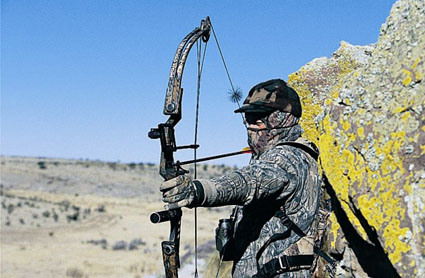<< Previously: Tactics For Ground Blinds, Treestands, Waterholes
More Mule Deer Tips
 Bow shots out West are longer than typical shots at Eastern whitetails. The author’s average shot on eight bucks he’s taken is 38 yards. Be prepared! |
In flat farm country getting a height advantage is important for glassing. Climb on top of haystacks, tractors, or hay barns to get a better view of the crops. Many times bucks will bed down in the crops so look for antler tips sticking up. That’s how I first spotted my September 2000 buck in Alberta. A small buck stood up to stretch. Upon closer scrutiny of the area around the little buck I saw big antlers just visible over the tops of the alfalfa. Talk to the rancher to find out where he sees the most deer and ask him which draws, canyons or windbreaks deer use to reach the agriculture.
Hunting muleys at 10,000 feet is strenuous, hard work. For this extreme style of hunting you need to be in top shape. Hiking from first light until dark for a week-long hunt while wearing a heavy backpack on little oxygen will exhaust even the best hunters. Plan ahead of time on how to get your buck off the mountain, either with the help of your hunting partner or with pack mules and horses.
Windy days are excellent for stalking bucks in CRP grass. The extra sound and movement of the wind rustling the grass will significantly increase your odds of getting in close. When glassing CRP fields early and late in the day, position yourself with the sun at your back if possible: It’s easier to pick out movement and the sun’s rays will light up bobbing antlers or wet noses in the distance.
Go through all the same scent eliminating precautions that you would do for whitetails when you hunt muleys from a blind. Only hunt the blind in a favorable wind. My routine goes like this: shower in non-scent soap, wear clothes that have been washed in non-scent laundry soap and stored in a garbage bag with several cedar branches (or other plants like sage or pine that are common to the hunting area), use fox urine on the soles of my boots in my approach of the blind, and spray fox urine around the blind in case deer get downwind.
I prefer lower stand heights, like 12 to 15 feet, because it offers a better shot angle. Most muleys have not been educated to hunters in trees so don’t put yourself so high that you have a poor shot. As long as the tree offers some back cover and you remain still and wear good camouflage, you should go undetected. If possible, set up where the sun is at your back and in the deer’s eyes, whether it’s a morning or evening stand.
When scouting several different waterholes, stomp out tracks around each one every day so you can get an idea of how many deer are hitting the water and at what time. After you hunt one waterhole, make the rounds checking the others for tracks. Stomp out new tracks and decide which blind has the most traffic or biggest tracks when deciding where to hunt next. If the ground around the water is too rocky to show prints, consider shoveling soft dirt around it so you can see hoof prints. Trail cameras are another scouting option.
No matter which tactic you use for hunting mule deer, good optics are always important because of the vast terrain that muleys prefer. Ten-powered binoculars, a variable-powered spotting scope, small tripod and laser rangefinder are all key ingredients for a successful hunt. Zeiss, Leica and Swarovski make my favorite 10 x 40 binoculars. I’ve used quality spotting scopes from Swarovski, Leupold, Bausch & Lomb and Cabela’s with good results. I usually start glassing with binoculars and when I find something of interest I’ll switch to the spotting scope. Heat waves and light conditions will dictate how high a magnification you can use with a spotting scope to still get a clear view of your target. Once within bow range I rely on a Bushnell laser rangefinder to determine the exact distance of the shot.
Shots out West for muleys are typically longer than the average chip shot at an eastern whitetail. I sat down and figured the average shot distance on the eight mule deer bucks that I’ve shot with a bow. The average was 38 yards. Only two of the eight bucks were shot at less than 30 yards. For shooting at 30, 40, 50, and 60 yards speed is a definite advantage.






